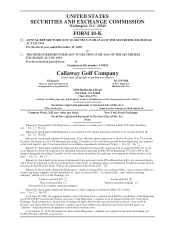Callaway 2009 Annual Report Download - page 20
Download and view the complete annual report
Please find page 20 of the 2009 Callaway annual report below. You can navigate through the pages in the report by either clicking on the pages listed below, or by using the keyword search tool below to find specific information within the annual report.generation, emission, release, discharge, treatment, storage and disposal of certain materials, substances and
wastes and the remediation of environmental contaminants (“Environmental Laws”). In the ordinary course of its
manufacturing processes, the Company uses paints, chemical solvents and other materials, and generates waste
by-products, that are subject to these Environmental Laws. In addition, in connection with the Top-Flite
Acquisition, the Company assumed certain monitoring and remediation obligations at its manufacturing facility
in Chicopee, Massachusetts.
The Company adheres to all applicable Environmental Laws and takes action as necessary to comply with
these laws. The Company maintains an environmental and safety program and employs two full-time senior
environmental engineers at its Carlsbad, California facility and a director of environmental, health and safety
matters at its Chicopee, Massachusetts facility to manage the program. The environmental and safety program
includes obtaining environmental permits as required, capturing and appropriately disposing of any waste
by-products, tracking hazardous waste generation and disposal, air emissions, safety situations, material safety
data sheet management, storm water management and recycling, and auditing and reporting on its compliance.
Historically, the costs of environmental compliance have not had a material adverse effect upon the
Company’s business. Furthermore, the Company believes that the monitoring and remedial obligations it
assumed in connection with the Top-Flite Acquisition did not have and are not expected to have a material
adverse effect upon the Company’s business. The Company believes that its operations are in substantial
compliance with all applicable Environmental Laws.
Sustainability
The Company believes it is important for the Company to conduct its business in an environmentally,
economically, and socially sustainable manner. In this regard, the Company has implemented an environmental
sustainability initiative which focuses on reductions of volatile organic compound (VOC) emissions, reductions
of hazardous waste, reductions in water usage, improved recycling and expansion of its Green Chemistry
initiative which involves the elimination or reduction of undesirable chemicals and solvents in favor of
chemically similar functional alternatives. These efforts cross divisional lines and are visible in our facilities
department through its Cool Planet Project (a partnership with our local utility company designed to encourage
large industrial customers to install energy efficiency projects in return for cost effective, user-friendly assistance
to measure and further reduce greenhouse gas emissions), in our manufacturing processes through automation
and waste minimization, in our product development processes through design efficiency and specification of
environmentally preferred substances, and in logistics improvements and packaging minimization. These
programs are routinely monitored through metrics reporting and reviewed by senior management.
The Company also has two existing programs focusing on the community, the Callaway Golf Company
Foundation and the Callaway Golf Company Employee Community Giving Department. Through these
programs the Company and its employees are able to give back to the community through monetary donations
and by providing community services. Information on both of these programs is available on the Company’s
website at www.callawaygolf.com. By being active and visible in the community and by embracing the tenets of
environmental stewardship, the Company believes it is acting in an economically sustainable manner.
Intellectual Property
The Company is the owner of approximately 3,000 U.S. and foreign trademark registrations and over 2,500
U.S. and foreign patents relating to the Company’s products, product designs, manufacturing processes and
research and development concepts. Other patent and trademark applications are pending and await registration.
In addition, the Company owns various other protectable rights under copyright, trade dress and other statutory
and common laws. The Company’s intellectual property rights are very important to the Company and the
Company seeks to protect such rights through the registration of trademarks and utility and design patents, the
maintenance of trade secrets and the creation of trade dress. When necessary and appropriate, the Company
7
























